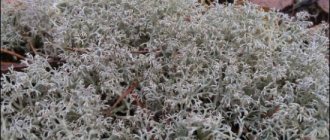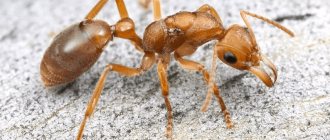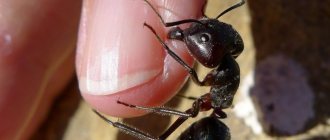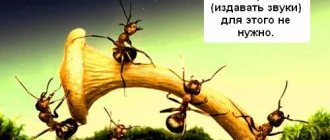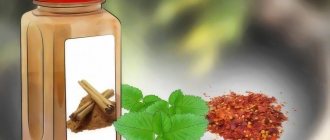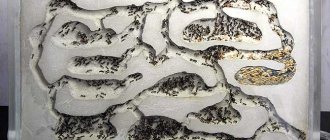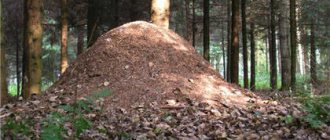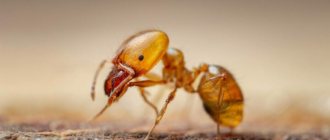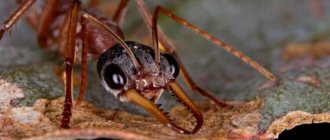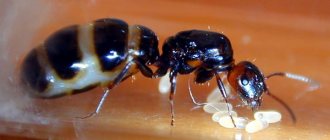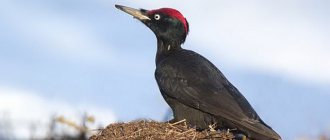- home
- Trips
- Orientation by moss and anthill
libre19 January 2013 66648
In the forest there lies a large stone-boulder, overgrown with fluffy moss on one side. Look carefully at this unusual compass, which was created by nature itself. We have already written about various signs of orienteering, orienteering in the forest and using a compass. We recommend reading these interesting articles.
Internal structure of an anthill
The inside of an anthill consists of many passages, corridors, chambers and compartments designed for specific purposes.
The rooms located on the upper levels of the anthill are heated by the sun in the summer and are used as a solarium for adult insects. The main building material for the interior decoration of an ant house is a mixture of soil with humus, particles of bark and everything that worker construction ants bring with them. A large number of passages connecting different rooms provide ventilation in the anthill.
At the middle levels of the ants’ home there are rooms with food storage, storage rooms for collecting garbage, and even an ant cemetery where dead compatriots are brought. The main entrances to the anthill are also located at the middle level, that is, at the foot of the outer hill.
A large space is covered by a special chamber designed for. In the lower layers of the soil they shelter from frost, providing themselves with everything they need during the summer.
How long do ants live?
This depends on a number of factors. The type of insect and caste, habitat, season - these are the main reasons that influence how long ants live in natural conditions. Worker ants live on average from one to three years. Smaller species have shorter lifespans than their larger relatives. Surprisingly, ants in cold regions live longer than their tropical relatives.
Males live for several weeks. During this period, they bring the only benefit to the population: they take part in mating. They are then destroyed by the colony or become prey to predators. The longest-living individual in the ant kingdom is the queen. In some species, its lifespan reaches 20 years.
Law of development: choose a profession you like
But, perhaps, what was even more unexpected was that the ants were found to have different personalities that influenced their choice of professions. In general, among social Hymenoptera (to which ants also belong), each individual usually changes several professions in life. Immediately after emerging from the pupa, she works inside the nest - as a nanny, as a cleaner, then carries out security service at the entrance to the nest or near it, and, finally, moves into the category of food collectors - foragers. In some species of ants, the matter goes further: different professions require different body structures, and by the time the larva pupates, it is a foregone conclusion whether this pupa will emerge as a soldier, a nanny, or even a living barrel for storing sweet syrup. But in most species, workers can change their professions. Moreover, as it turns out, in accordance not only with age, but also with the needs of the family and one’s own inclinations. For example, almost all adult ants go through the profession of nanny, but the overwhelming majority of them then move on to other occupations, while some remain nannies for life. On the other hand, when in an experiment scientists completely removed nannies from some nests, some of the foragers returned to this profession and, in most cases, successfully coped with it.
Transport of leaves by leaf-cutter ants (Peru)
However, within each profession there is a choice. While getting food for your family, you can be a hunter, alone exploring distant areas in search of game. If he is lucky, the hunter will provide his family with a substantial portion of valuable animal protein, but no one guarantees him this luck. Or you can be a shepherd, walk a familiar path every day to the same branch of a plant where a colony of aphids sits, and return to the anthill with a constant yield of honeydew (the sugary secretions of aphids). Some foragers scout out rich sources of food and, returning to the nest, mobilize their comrades to develop them, while others only respond to such calls. Special studies have shown: under normal conditions (when there is no acute shortage of workers in a particular specialty in the family), it is not the profession that shapes the individual character of the ant - initiative, curiosity, the ability to captivate others, etc. - but this character determines the choice of profession. Scouts, observers, and coordinators of construction activities make up a very small part of the anthill population. But, as far as one can judge, they are the ones who make the decisions.
black ant
This species is also one of the most common and often settles in human homes. Their color is usually black, but can be dark brown. The entire body of the insect is covered with small villi. Usually anthills are built in the soil, and there is a mound on top. They can also build their homes in wood and under boulders. Sometimes you can find a larger black ant - in this case, you have stumbled upon another representative, it is called the reaper. This species is known for its tendency to store huge reserves in the anthill. They can collect about a kilogram of seeds and insects to successfully overwinter. It is interesting that, unlike other ants, they feed their larvae with plant food, and not insects.
But the types of ants that are found in Russia do not end there. For example, many people know wood borers that run along branches and collect honeydew on leaves, and establish their colonies in stumps or under the bark, gnawing passages. Also in the country there are some species of “Amazons” that do not give birth to workers, but steal larvae from more peaceful ants. The babies that are born think that the Amazons are their parents and begin to do all the “dirty” work for them.
How to navigate an anthill in the forest
A landmark that will never let you down is a simple anthill. Ants live in almost any area. There are about 12,000 species of them and they adapt perfectly to any conditions. They do not live only in harsh natural conditions, such as deserts and cold northern regions. They are heat-loving insects and predominate mainly in warm regions. In conditions close to harsh, for example, in a temperate climate, they hibernate during the winter.
Anthill orientation
There are a huge number of types of ants and anthills, but the principles of their construction are the same. So, how can you navigate an anthill? The rules of reference are quite simple. Since ants prefer warmth, they build anthills on the south side of trees or other vegetation. Cold winds usually blow from the north, and the wide trunk of a tree serves as an excellent barrier from the wind. If you see a large anthill next to a tree or bush, then south will be exactly in the direction of the anthill from the tree.
There is another important feature of the anthill. The shape of the anthill will help you determine how to navigate the terrain using an anthill. If you find an anthill in a steppe area and it stands separate from the vegetation, it’s not a problem. The fact is that any type of anthill has a flatter shape on one side and steeper on the other. The flatter side is located towards the south, and the steep side is towards the north. This feature is again due to the fact that ants love warmth and the steeper side serves as a barrier from the wind.
However, the anthill is an imprecise natural landmark; the celestial bodies are more accurate. You can read how to navigate by the Moon and how to navigate by the Sun on our website.
- The eggs laid by female ants are commonly eaten by Mexicans and Africans. They believe that eggs have a lot of protein and nutrients.
- The longest life expectancy of a uterus is 14 years; the recorded case is a world record.
- African tribes use bullet ant venom in male initiation rites. The hand of a boy undergoing a rite of passage is dipped into a container of ants, after which the hand becomes swollen and very painful. It is believed to induce resilience in boys.
Anthill
Once again, how to navigate the anthill briefly:
If you find an anthill in the middle of the forest and it grows next to the trunk of a tree or bush, then south is located on the side of the anthill from the tree. If you find an anthill in a steppe area, you should pay attention to its shape. The flatter side of the anthill is directed to the south, and the steeper side is directed to the north.. With this knowledge of terrain orientation, you can easily determine where the south is and where the north is, because it is very easy to remember
With this knowledge of terrain orientation, you can easily determine where south is and where north is, because it is very easy to remember.
And we saw what an anthill looks like. It is a small hill rising above ground level, covered with many twigs, leaves and blades of grass. The little inhabitants of this house are constantly scurrying around him. But not many people know how an anthill works from the inside.
Unique abilities
The ability of these insects to almost always return home, even if they move a considerable distance away from it, has always surprised and continues to surprise scientists. Today, experts have enough knowledge to explain how an ant colony is organized, how they live, how they work, and, among other things, how they find their way to the anthill.
Ants easily find their way home leaving pheromones on their way
This ability is based on a whole complex of mechanisms, both physical and chemical. The ant's body is very complex in terms of the development of the endocrine and nervous systems. Using certain abilities, the insect is able to find its way home without any problems. In the wild, no factor can create any obstacle to this. Only a person can disrupt an ant’s ability to navigate in space by creating an artificial obstacle for it.
other methods
Forest inhabitants will help tourists navigate the terrain without a compass or map. The squirrel inhabits only hollows protected from the prevailing winds. Insect paths on tree trunks are often on the south side. Migratory birds fly north in the spring and south in the fall. In spring, the snow begins to melt on the southern slopes of hollows and ravines, and the grass here is subsequently thicker and taller. In summer, on hot days, there is lush grass on the northern side of buildings, stones, and forest edges. The soil is drier and berries ripen earlier on southern slopes.
Using a nail, a sewing needle, or a piece of wire, you can make a homemade tourist compass. At the same time, you need to understand that it will point to the magnetic pole and there will be a small error. This piece of steel must be magnetized by rubbing it on wool. In one case, it can be tied on a long thread by the center of gravity, it will rotate and stop in the north-south position. In another case, a magnetized needle is placed on a dry leaf in a small pond, the needle will indicate the north-south direction.
Given all the knowledge about orienteering without a compass, you should remember that you should not use one or two methods. Use your knowledge repeatedly, test it and if several observations are correct, the group will find the right direction.
Anthill It is difficult for a lost person to figure out the forest. If you don’t have a compass at hand, you have to wander endlessly between identical plants, hoping for luck. But nature took care of the lost travelers. There are many clues around that can lead you out of the thicket. If you know which side of the tree the ants build their anthill on or where the moss grows, you can quickly find your way home.
Determining the sides of the horizon in winter
With the arrival of cold weather and snowfall, we use some of the previous methods, as well as some others, to determine the direction. For example, everyone knows that at the end of winter and spring, the growing rays of the sun form the first thawed patches: near trees, stumps and pillars located in open places, holes elongated in a southern direction are formed.
In the same way, the slopes of ravines and hills located on the south side are cleared of snow faster. These signs will tell you the direction to the south.
It is better not to move through the forest at night, there is a high probability of getting damaged while making your way through the jungle, and an encounter with wild animals is also possible, so it is better to wait it out by the fire. But if there is a need for this, only the moon and stars will help determine the direction of movement. You can read how to do this here.
In conclusion, I would like to add that your foresight and memory will provide invaluable assistance in a safe visit to the forest.
On the way to the forest, remember the landmarks you encounter: power lines, rivers, roads and railways, and in the forest itself, pay attention to such objects as deep ravines, large clearings, trees, forest roads, etc.
Before entering the forest, look at the clouds, remember in which direction they are moving, in the future they will help determine the approximate path back because their movement remains unchanged for a long time.
And we should not forget that each method will not give an exact direction, so it is necessary to check them with other signs, drawing a conclusion only on their complex.
How to navigate the forest is a question that interests any novice traveler. However, these skills are useful for everyone. The ability to navigate correctly will help a lost mushroom picker, a hiker, or just a person who likes to take a walk in the forest.
Orientation by the sun and stars
To navigate by the Sun on a bright sunny day, you should wait until midday. At this time, the luminary is at its zenith, any shadow cast by objects becomes short. You should stand with your back to the luminary; the tourist’s shadow will indicate the direction to the north. The south will be behind the traveler. On his right hand there will be an eastern direction, on his left hand - a western direction.
In the off-season, on spring and autumn days, the sun will rise strictly in the east and set in the west. At noon in any season, the star is in the south and every shadow points to the north. On winter days, the sun will rise from the southeast and set from the southwest. On summer days, the sun will rise from the northeast and set from the northwest.
Any traveler has an idea of the constellations of his northern sky. Today, almost every schoolchild can find the stars Ursa Major and Ursa Minor in the sky. But although tourists may theoretically know that the North Star is the end star on the tail of Ursa Minor, finding it can be quite difficult. The advice to help with this is to find the two terminal stars in Ursa Major and mentally continue the line connecting them to the bright Polar Star. Standing facing it, the tourist will look north.
Table: determining parts of the world by the sun
Ant Society
The structure of the “social life” of an anthill is even more complex than the structure of life in a hive. Ants are a lot like people. For example, slavery is common in some species. Ants attack someone else's anthill and steal the pupae. Having then grown up in someone else's anthill, the captives work for its benefit. It would seem, what kind of slavery, when the unfortunate workers do nothing but selflessly work for the benefit of the queen and the males all their lives. But usually ants work for the prosperity of their own species and their own colony. By the way, huge Amazon ants specialize only in “military actions”: only stolen slaves work for the benefit of the anthill.
There is a more sophisticated way to seize power. There are species of ants whose female can literally charm ants of another species. She comes to a foreign colony, and the workers simply give her their own queen to be torn to pieces, and subsequently serve the guest.
Ants: general characteristics
Ants are insects that live in almost all corners of our planet, with the exception of Greenland and Antarctica, as well as some oceanic islands.
They populated not only steppes and forests, but also deserts. There are 13.5 thousand species of ants, 300 of them are common in our country. Ants belong to the order Hymenoptera, phylum of arthropods, class of insects, family of ants. These are social insects, clearly divided into three castes: males, females, and workers. These little hardworking creatures cannot live alone, so they always create colonies.
@theqstn, undefined
THE AUTHOR OF THE QUESTION APPROVED THIS ANSWER
And who said that ants someday stop building an anthill? They are constantly building and rebuilding it, sometimes more actively, sometimes less. The larger the population of an anthill, the more it grows in height and width. At some point, when there are too many ants and it is no longer possible to organize their mass, part of the family separates and builds a so-called “bud” - a daughter anthill not far from the first. Some of the workers go there along with the brood and females. But anthills do not grow upward indefinitely, simply because it is inconvenient. At some point, something begins to collapse, some structure becomes inconvenient, and then they begin to rebuild it or build it wider instead of upward. This is not just some kind of heap, but an architectural structure with an underground part and an internal cone - a structure made of twigs that holds the entire dome. Sometimes, when for some reason part of the ant family cannot branch off and begin building a daughter anthill, the structure becomes truly huge - up to two meters in height. But for this to happen, it is usually necessary to have some kind of dead stump inside as a cone, and this does not happen very often.
2
The answer to the question cannot be given, since the ants never stop working on the anthill. To understand at what point an anthill stops increasing in volume, you need to look at its development cycle.
As a rule, most species of ants build an anthill as needed - the number grows, the ants dig new chambers, and bring the soil to the surface. Over time, a hill grows from above around the entrance, in which the ants build more chambers. Then the cycle repeats again and continues until the colony reaches its maximum number - from that moment on, the chamber system occupies approximately the same volume and no longer requires expansion.
But even after this, the anthill continues to change - some galleries will be flooded with water during rain, plants will sprout somewhere and make holes - the ants have to quickly rebuild the anthill to suit the changing environment.
38
In general, the big question is why the actions of ants are coordinated and appropriate. This is a question about the essence of intelligence. Sometimes they say about ants that they are carriers of the so-called distributed intelligence. Each ant is just a simple insect. And all together they perform rather complex actions, including building an anthill of a certain design and size, obtaining food, and guarding eggs. How such a result could arise as a result of evolution is not entirely clear. Some kind of adaptation to environmental conditions is understandable. But here we are talking about something more than a simple device. Apparently, these insects are born with abilities and behavior algorithms already recorded in memory. Where did they come from, these algorithms? Or they appeared on their own. Or someone wrote it down.
Is it possible to confuse an ant?
It is known that these small insects can live next door to a person, for example, in his own house, causing a lot of inconvenience. In this case, the ants turn into pests. If you know how to disrupt the ability of insects to find their way home, you can effectively get rid of them in the kitchen or other room.
Indoors, as a rule, only a few mechanisms are involved, namely chemical, physical, step counting and magnetic field orientation. All of them can be broken. For example, you can first trace which route the ants are moving and scatter some strong-smelling substance here that will kill the smell of pheromones.
Constantly rearrange objects in the kitchen - cups, spoons, plates and other utensils, so that the ants seem to be in a new place every time. You can even place small magnets so that the insects are confused and cannot navigate by the magnetic field. Regularly clear all food from tables, including small crumbs. As a result, the food will be at a different distance each time, which is why the ants' ability to count steps will lose its relevance.
Internal buildings
The inside of an anthill is much more interesting. I am amazed by the smooth work of the builders, their thoughtfulness, ingenuity and tolerance. Inside, the anthill looks like a collection of passages, exits, and all kinds of cameras.
The building goes underground, is divided into 2 parts, and accommodates an entire colony of inhabitants.
- Insects spend most of their time in the upper tier and live during the warm season. The chambers are well heated, providing ideal conditions for raising offspring.
- The lower part has similar structures and goes 1-2 meters underground. There, insects spend the winter, wait out cold days, and store food supplies.
Each of these parts is divided into chambers that perform their own functions.
- Queen's room. The queen lives in it and lays eggs. She is looked after by worker ants who help lay eggs.
- Egg room. Ants lay eggs here and ensure proper conditions are provided.
- Room for larvae. Hatched ants have the shape of worms and are particularly voracious. They are placed in one chamber, several at a time. Provide food.
- Food storage room. Separately for seeds, grains, aphids, parts of other insects.
- Garbage warehouse.
- Tombs for dead ants.
- A wintering room where insects wait out the cold at rest.
The cells are connected to each other by numerous passages; there are several exits, carefully guarded by soldiers. With the approach of danger, the onset of cold weather, the openings of the anthill close. A cross-sectional photo of the wonderful structure is shown below.
Anthill in section
Orientation by temples and glade pillars
Orthodox churches and Catholic churches are built oriented towards the cardinal points. Just look at the crosses located on the Orthodox church, the lower part of the lower crossbar points to the south, the upper to the north.
The entrance to the temple and the bell tower are located on the west side, the altar in the church is located on the east. In Catholic churches, on the contrary, the altar is located in the west. For Muslim mosques, it is more difficult to determine the sides of the horizon; they are oriented towards Mecca. Likewise, Jewish synagogues are oriented towards Jerusalem. Although the doors of synagogues and mosques are in the north.
If you manage to find a clearing in the forest, if necessary, you should look for a post with bright numbers on it. They will point tourists to the square number of the topographic map of the area. The smallest numbers of the cutting column will point to the north.
Where is the anthill located?
There is little sunlight in the forest. Warm rays barely break through the dense foliage of the trees. And they are insects that love warmth. Therefore, little hard workers try to get the maximum possible sunlight for the anthill.
They will build in a place where they are more likely to receive heat. The trunk and crown provide a powerful shadow, which means that the ant house should be placed where the tree will not interfere - on the south side.
If an insect nest is located in a clearing, then it is worth inspecting its slopes:
- the southern part is flat;
- the opposite side will remain steep.
You need to remember how to navigate the anthill
But it is worth paying attention to other details. So, mushrooms grow from the north of the stump, and berries turn red faster from the south
A dark stripe forms on the northern part of the pine, and the opposite side is covered with sticky resin. This knowledge will help you navigate the thicket and get out of it before dark.
Anthill in section
Anthill in section.
The structure of an ant.
A typical anthill, in which the red wood ant family lives, has a complex multi-chamber structure. Up to one and a half million ants can live in such a structure, erected on an old stump.
1.
Covering with needles and twigs. Protects the home from the vicissitudes of the weather, repaired and updated by working ants.
2.
“Solarium” is a chamber heated by the rays of the sun. In the spring, the inhabitants come here to warm themselves.
3.
One of the entrances. Guarded by soldiers. Serves as a ventilation duct.
4.
"Cemetery". Worker ants carry dead ants and garbage here.
5.
Wintering chamber. Insects gather here to survive the cold in a state of semi-hibernation.
6.
"Bread Barn" This is where ants store grains.
7.
The royal chamber where the queen lives, laying up to one and a half thousand eggs a day. She is looked after by worker ants.
8.
Chambers with eggs, larvae and pupae.
9.
"Cowshed" where ants keep aphids.
10.
A “meat pantry” where foragers bring caterpillars and other prey.
Ant structure
There are an estimated billion billion ants in the world, belonging to 12 thousand species. Their total biomass is approximately equal to the biomass of humanity.
1.
A brain consisting of approximately 500 thousand neurons.
2.
Intestines.
3.
The stalk is a narrow part of the body that connects the thorax to the abdomen and gives flexibility to the movements of the insect.
4.
Metapleural gland. Produces antibiotics that protect the ant from bacteria.
5.
Nervous system. Consists of three thoracic and several abdominal ganglia.
6.
Goiter. Contains liquid digested food, which the ant regurgitates and transfers to other members of the colony in the process of trophallaxis - food exchange.
7.
Chitin exoskeleton. Protects the body, ensures its strength and serves as a support for muscles.
8.
Sting. Not available in all species.
9.
Dufour's gland. Produces pheromones that serve as signals for ants following the trail.
10.
A leg consisting of five sections.
11.
Poisonous gland. The red ant produces formic acid, and in some other species it produces a paralyzing poison.
12.
Stomach.
13.
Eye. Visual acuity varies between species. Some see objects hundreds of meters away, other species are almost blind.
14.
Mandibular (jaw) gland. Releases alarm pheromones when attacked by a predator or when strangers appear.
15.
Spur on the leg for cleaning antennae.
16.
Claws. There are two of them on each leg, between them there is a pad that secretes a sticky liquid that allows the ant to walk on smooth or inclined surfaces.
17.
Antennas, with the help of which the ant receives information about the smell, taste, chemical composition, texture of various objects and exchanges it with its fellows.
18.
Postpharyngeal (retropharyngeal) gland. Fats intended for feeding the larvae are produced and stored here.
19.
Mandible. They serve for capturing and chewing food, and also as a weapon.
See the issue on the same topic
If you are a fan of frequent walks and long hikes in the forest, then you need to have many useful survival skills in the wild. Such knowledge includes the ability to navigate the terrain well without a compass. There are a variety of natural landmarks, and one of these is an anthill.
Physiological features
The body structure of these insects is divided into three parts, covered with a chitinous shell: the head, as well as the chest and abdomen connected by a thin waist. The eyes, which consist of many lenses, distinguish movement, but do not produce a clear image. Ants move with the help of six thin legs with claws at the ends, which allow the insect to climb upward.
The antennae, segmented, are located on the head. These are organs of touch that not only detect odors, but also feel the vibration of the soil and the movement of air currents. The structural features of the insect and the size of the ants depend on their species, as well as their status in the colony. On average it ranges from 1 mm to 3 cm.
The largest individuals in some species are females, in others their size is no larger than the size of working individuals. Females have wings that fall off after the mating season. The colors of ants can vary from black, red, yellow and brown to unusual green or bluish. Ants are difficult to classify, since twin species and numerous hybrids are common in nature. Only specialists can distinguish them by appearance.
Anthill diagram
Anthill diagram
Ants always choose a place for an anthill and materials for their house carefully. The anthill itself consists of an above-ground part and an underground nest. On top it is covered with twigs and needles, which protect the home from bad weather. And even if it looks unattractive in appearance, there is a whole town inside.
Inputs and outputs
Anthill in section
Entrances and exits serve not only to enter and exit, but also perfectly ventilate the room. The strongest and largest ants guard the entrance to the anthill, covering it with their body. Before it rains, the entrance is closed to ensure that all passages and chambers remain dry.
Solarium
This is usually the upper chamber, or room. Due to its location, it heats up very quickly and ants come here to warm themselves. And in the spring, they can spread heat on their bodies, warming up the entire anthill.
Cemetery
If you go lower down the anthill, you may stumble upon piles of dead ants and garbage. All this is put into a separate cell, which is not very deep and not far from the ventilation.
Wintering chamber
Like bears, ants also hibernate to survive the harsh cold. For this they need their own den. Usually it is located somewhere in the middle of the anthill.
Storage
Ants store plant seeds in storage in case they cannot find food for themselves. Some ants take care of the food and even take it out into the sun to dry it.
Royal chambers
The queen of ants, the queen, lives in the royal chambers. Usually she is also the first resident in her colony. The queen very rarely leaves the anthill. The whole point of her life is to lay eggs.
Nursery and kindergarten in an anthill
These are chambers in which eggs, larvae and pupae are stored. Nannies are nearby all the time, because the larvae need food and round-the-clock supervision. They move them up or down the anthill depending on the weather, trying to always keep them warm and in the required humidity.
Pantry
The place where all the most nutritious things are located. This is where the ants store caterpillars and other food they have caught.
During its life, an ant can perform only one job, and can even change with other ants. But he carries out any assignment with great precision and dedication. Work that requires great physical exertion is often performed by young and hardy ants.
What do ants do
Very few people who are not seriously interested in this issue have any idea how an anthill works. But this is truly a complex society.
To begin with, it is worth noting that all ants are divided into three groups: the queen (aka the queen, the only one in the anthill), males (up to several dozen, needed to fertilize the queen) and workers. It is the latter that is worth talking about in more detail.
Some experts identify up to ten specialties that include working ants. Moreover, each of them is engaged in his own business from birth to death, and has a certain structure for this. For example, soldier ants have a particularly large head - if necessary, they can block a passage with it, preventing the enemy from entering a long corridor. Nurse ants are distinguished by very delicate antennae, which allow them to detect the slightest movements in the pupae and eggs. The midwives who directly care for the queen are very similar to them. They feed her, remove waste products, stroke her, helping her lay new eggs (several thousand a day). Loader ants have powerful necks and legs, thanks to which they lift enormous loads for their bodies. Builders have glands that produce sticky saliva that is used to hold building materials together.
And this is not counting the highly specialized ants that are found in specific anthills, depending on the direction of their economy.
Career ladder
Typically, a worker ant changes several professions during its life. The young are busy inside the nest: they look after the female (“retinue”), children, that is, eggs and larvae (“nannies”), and older workers (“grooms”), clean and repair underground chambers and passages (“repairmen”), store water (“barrel ants”).
After working for 1–3 years and gaining experience and qualifications, the ants are transferred to the reserve, where they can rest a little and allow new generations of young workers to take care of themselves. Approximately a third of the “proletariat” is in reserve, but they must be constantly prepared to deal with the consequences of accidents and natural disasters.
Exterior view of the ant house
What ants build an anthill from can be seen from the outside - dry twigs, sticks, blades of grass, leaves, piles of earth, moss and other building materials that hardworking insects can carry.
From above, the house looks like a cone-shaped mound with small holes - entrances. This shape allows the anthill to warm up well in the sun, not get wet in the rain, and gain access to oxygen.
The anthill rises above the grass so that the surrounding vegetation does not block the sun's rays. Over the years, they build it up to several meters in height. Droplets of rain, falling on a numerous layer of sticks, twigs, leaves, roll down and do not penetrate inside. Open entrances, guarded by a large army of soldiers, serve as ventilation shafts through which air constantly circulates.
Appearance of an anthill Scientists have recorded the largest structure in the Tomsk region - 3 m in height, 5 m in diameter. The anthill supposedly took 20 years to build.
Tree navigation
If tourists find themselves without a compass in an unfamiliar forest area, they need to look carefully at the trees. In the south, the tree crown is more luxuriant and there are significantly more leaves. The densest branches in the dense forest develop here; the sun heats them better. Trees reach out for warmth with every leaf. In the north there are much fewer leaves and branches.
The method is not absolutely correct; allowances must be made for prevailing winds, the presence of moisture, and soil types. It is more reliable to navigate along lonely growing trees than in a dense forest.
You can navigate by the bark in a birch forest; from the south it is always lighter, more elastic and thinner. Roughness and cracks, dark growths form on the trunks of birch trees from the north. Birch is a very flexible, thin-trunked tree in young forests; the tilt of the trunk will indicate the direction of the prevailing winds.
You can navigate by the cut down stump; you just need to carefully examine the annual rings on it. Where the gaps between the annual rings are larger - south, and where the rings are located close to each other - north. It’s good if you come across a clearing with cut trees along the way. Even a few stumps will help confirm your orientation assumptions.
In the forests along which tourist routes pass, there are special signs called tourist markings. They are painted on the trunks along a planned route, always from the nearest populated area.
Strict hierarchy
In the photo, a cross-section of the inside of the anthill looks like a labyrinth. But in this maze everything happens according to an algorithm. Each insect has its own responsibilities, which are assigned to it immediately after its birth. An adult can choose a role for herself according to her preferences:
- construction ants;
- nannies;
- maternity ward workers;
- transporters;
- warriors;
- security guards;
- scouts;
- food getters.
The most responsible and valuable profession among ants is caring for their offspring. Only ants close to the queen receive it. Stronger and more aggressive individuals become good warriors and home guards. Insects with navigation skills become scouts for new territories to search for food. Strong and resilient members of the colony carry food and cargo along the countless passages of the anthill.
Housing construction is carried out by the lowest classes. Often an anthill is built by individuals who were enslaved during the next raid on neighboring colonies. During such military campaigns, insects can penetrate the enemy's chamber with pupae and steal them. The ants hatched from the pupae may even be of a different species, but this does not prevent them from becoming lifelong slaves from birth.
An anthill with ants demonstrates a highly organized form, where each resident contributes to the common cause. Scientists still do not understand what controls all members of the colony, because they do not have a think tank. But this does not prevent the ants from running their household, raising their offspring and organizing their life within the walls of a huge house.
From rags to riches, or career growth
Most ants at a young age often try to find themselves in different professions, working as a nanny, a builder, or a shepherd. They are looking, so to speak, for themselves, just like us people! Those who “like a daisy” cannot decide in any way are destined for the role of general workers, since lazy people and losers are not treated on ceremony here.
Having worked for about a year or three years, they are experienced and qualified, they are included in the “personnel reserve”, always ready to begin eliminating accidents and disasters. They are also appointed to other positions from the reserve.
In the struggle for a place in the sun, they know how to survive their competitors. To do this, ants - candidates for the position jump on each other, trying to be taller, walk on outstretched legs and bite with their jaws.
The triumphant man forces his competitor to bend over in the “suitcase pose,” drags him into an anthill and throws him somewhere so that he does not interfere with his career. Doesn't remind you of anything?
Do you know that?! Workers love and know how to relax. They do this within the walls of the house, falling into nirvana, rocking on their legs in their sleep.
Interesting life inside
From birth there is a division into castes.
- Most of the family are worker ants. One half provides coziness and comfort inside the structure, the other half brings food from the outside environment and builds a house outside.
- At the head of the hierarchy is the female, who is also called the uterus, the queen. Once fertilized at a young age, it produces offspring throughout its entire life. Finds a place for the future anthill. In 14 days, full-fledged ants emerge from the eggs, mainly a working clan. Accepted for the building.
- A small part of the society are young males. Their fate is not so happy. After fertilization, the young females die within 2 weeks.
Each ant has its own individual smell. All inhabitants of a single anthill also differ in their specific aroma. By smell, a society distinguishes its resident from a stranger. With the help of specific aromas, they report the presence of food, danger, and different-sex individuals find each other for fertilization.
Life of an anthill In ant society there are more than a dozen “professions”:
- scouts;
- invader warriors;
- soldier guards;
- builders;
- orderlies;
- nannies;
- breadwinners;
- shepherds, milkers;
- transporters;
- nurses;
- guardians of food and nectar;
- midwives.
Life in an anthill continues for years. If there is a threat of collapses or damage, the ant family begins to build another home in the immediate vicinity to make it more convenient to drag supplies, eggs, and larvae.
The structure of an anthill resembles a large city with a developed civilization, division into societies, and a clear distribution of responsibilities. A simple structure on the outside is a complex structure on the inside.
Use of chemistry
Finding your home using scent marks - what could be easier. Everyone leaves chemical information about themselves. This is an individual smell that can be recognized by every animal with a good sense of smell. This is how all canines and cats search for their prey.
Ants, of course, leave their body odor on the trail. However, each ant smells, first of all, of its own anthill. Using these individual marks, any individual from a given anthill can find both its fellow and its home.
By the mark left on the ground, they can determine the age of the trail and the condition of the ant. So a chemical mark left by one ant will help all the other ants of this family find their home.
